People in Peril: Indians in South Africa
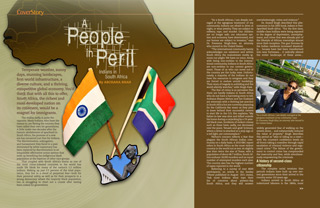
Temperate weather, sunny days, stunning landscapes, first-world infrastructure, a diverse culture, and a thriving, competitive global economy. You’d think that with all this to offer, South Africa, the richest and most developed nation on its continent, would be a magnet for immigrants.
The reality, sadly, is quite the opposite. Many Indians, who have the means to, are fleeing the country they have called their own for generations. A little under two decades after the historic abolishment of apartheid in South Africa, the promise of a new era has remained just that for Indians. The discrimination, subjugation, and harassment they faced in a past dominated by white supremacy has been replaced by discrimination in an inequitable affirmative action system that ends up benefiting the indigenous black population at the expense of other race groups.
That coupled with South Africa’s status as one of the most crime-infested countries in the world has made life bleak for many of the nation’s 1.2 million Indians. Making up just 2.5 percent of the total population, they live in a cloud of perpetual fear—both for their personal safety as well as for their prospects in a young democracy where the majority black population, too, is struggling to chart out a course after having been cowed for generations.
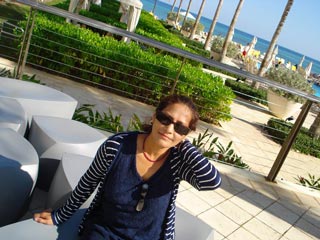 Dr. Praveena Singh-Kaw, an attorney who moved to the United States.
Dr. Praveena Singh-Kaw, an attorney who moved to the United States.
“As a South African, I am deeply outraged at the egregious treatment of my community. Indians are afraid to drive at night, or wear jewelry. They are subject to robbery, rape, and murder. Our children are no longer safe, our education system and economy have deteriorated, and our homes are subject to invasion,” says Dr. Praveena Singh-Kaw, an attorney who moved to the United States.
“The international community barely acknowledges our existence and within South Africa the mainstream media ignores our plight. We have no voice. Along with being non-entities to the international community, Indians in South Africa are non-entities to our current government. Those of us who can move out of the country are the lucky ones. Unfortunately, a majority of the Indians do not have the resources to emigrate and they are forced to endure untold hardships. Their story of tragedy is unfolding and the world silently watches,” adds Singh-Kaw.
The fear of crime is so pervasive that there are hardly Indians in South Africa who do not have a harrowing story to tell. Arshana Shyam Nirhoo and her husband are attorneys with a thriving law practice in South Africa but are currently preparing for the California Bar exam as they plan to leave behind their successful careers to start life in the U.S. She explains, “My father-in-law was shot and killed outside his home during a carjacking by a 19-year-old black man. Incidents of violent crimes such as these have, sadly, not decreased over the years. ‘Smash-and-grab’ [crimes], where a driver is attacked at a stop sign or a red light, are commonplace.”
Nirhoo’s concern reflects a fear that plagues the South African Indian community on a daily basis. A 2010 BBC report refers to South Africa as the most violent country in the world not at war. At slightly less than twice the size of Texas, with a population of about 48.7 million, South Africa endures 18,000 murders and an equal number of attempted murders each year. The country also has the highest number of rapes reported in the world.
Referring to a survey of over 8000 participants, an article in the Sunday Tribune published in August 2011 states, “Ask most Indians what tops their list of concerns about present-day South Africa, and they will answer overwhelmingly: crime and violence.”
Dr. Anand Singh described this phenomenon in his 2005 book, Indians in Post-Apartheid South Africa: “For the first time, middle-class Indians were being exposed to the degree of deprivation, unemployment, and crime that was already part of the lifestyle of African townships almost since their inception. The gun licenses by the Indian residents increased drastically… houses have fast been transformed into near fortresses… it radically altered the entire landscape of these areas… widely generated fear of walking on the streets alone… and substantially reduced the value of property.” Singh describes this period as “akin to riding on a crest—with the country’s confidence levels on all fronts taking a nosedive through rapid escalation of criminal violence and organized crime.” The failure of the government to control crime has compounded the insecurity and fear, while simultaneously empowering the criminals.
A history of second-class citizenship
The complex racial tensions that perturb Indians have built up over several generations since their arrival in the country some 150 years ago.
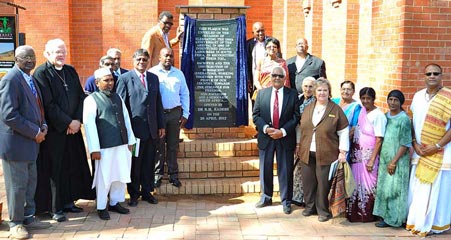 A memorial at the Talana Museum in KwaZulu Natal honors the legacy of indentured laborers from India.
A memorial at the Talana Museum in KwaZulu Natal honors the legacy of indentured laborers from India.
Indians arrived in South Africa as indentured laborers in the 1860s, most from Tamil Nadu and Andhra Pradesh, and some from Uttar Pradesh and Bihar. They were contracted to work on the sugar plantations but later also worked in coalmines, railways, dockyards, and municipal services, and as domestic workers.
A much smaller second wave of “passenger” or “free” Indians came to South Africa after 1880, mainly as traders from Gujarat attracted by new opportunities. These immigrants set up retail shops. Much later, teachers, accountants, lawyers, priests, and other professionals arrived, also mainly from Gujarat.
Their struggle started from the time they first set foot in the country. The white colonists who recruited the Indians referred to them as “coolies” and perceived them in mechanistic terms. An editorial in the Natal Witness aired these views brazenly: “The ordinary Coolie and his family cannot be admitted into close fellowship and union with us and our families. He is introduced for the same reason as mules might be introduced from Montevideo, oxen from Madagascar or sugar machinery from Glasgow. The object for which he is brought is to supply labor and that alone. He is not one of us, he is in every respect an alien; he only comes to perform a certain amount of work, and to return to India.”
The indentured laborers were overworked and malnourished, and had to endure squalid living conditions described by historians in such terms as “primitive,” “brutal,” “inhuman,” and “akin to slavery.” One Indian recorded of an employer: “He uses whatever comes next to hand: stones, sticks, sjambok. He treats the Coolie like a bull buffalo.”
As word about the oppressive treatment reached India, the South African government set up the ‘Coolie Commission’ in 1872 at the insistence of the Indian authorities. The Commission exposed the ill-treatment of Indians, including illegal withholding of wages and rations, lack of medical attention, complaints of flogging and assaults, fines in excess of the law, and excessive working hours.
The indentured system ended in 1911, but only 23 percent of immigrant laborers returned to India. Those that remained continued to be victims. Segregation and inequality, which had always existed in South Africa, were enshrined in the law when the Nationalist Party came into power in 1948. “Indians are a foreign and outlandish element which is inassimilable,” the Nationalist Party declared in its election campaign, and vowed to repatriate as many Indians as possible. With the enactment of apartheid in 1948, racial discrimination was institutionalized and Indians, along with non-white race groups, found themselves completely shackled by the government’s racist policies.
The race laws dictated almost every aspect of life, including the sanctioning of “white-only” jobs, specifying where non-whites could live and buy property, and which schools and universities they could go to. Marriage and sexual relations between whites and non-whites were, of course, banned.
Even in life-and-death situations, patients could receive blood transfusions only from donors of their own racial groups, had to be conveyed in racially exclusive ambulances, and could qualify for treatment only in racially defined hospitals.
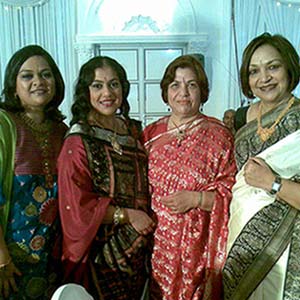
It was only as a teenager that Harshna Kanaye (second from left) found out the reason behind all those childhood camping trips with her family in the South African countryside—it was not just that they were the adventurous, outdoors type.
Harshna Kanaye, who immigrated to Atlanta in 2010, recalls her childhood under the segregation laws: “One of my fondest childhood experiences was going camping with my Mum, Dad, and two older sisters. I always thought we were so adventurous and I relished those trips to places like Coffee Bay and Port St. Johns where crayfish were bountiful. My Mum, armed with her masala and rolling pin, would make the most delicious crayfish curry and roti I have ever eaten in my life.
“It was only much later as a teenager, when my Mum and I were talking, that I learned the reason for our camping trips. Yes, we were adventurous. But the camping [was a] necessity. Being Indian, we were not allowed to stay at any hotels along our way. It is hard to describe the feeling of being excluded. As a child I used to think, ‘Don’t they know that we’re good people? Don’t they know that we live in a nice house and we have lots of friends that like us?’ But eventually, as we accumulated a collection of camping gear through the years, when the time finally came for us to be ‘allowed’ into the same hotels that once turned us away, all we really wanted to do was pitch a tent anyway.”
The South African government pushed the envelope on segregation with the highly insensitive Group Areas Act of 1950 that forcibly removed non-whites from their homes. The act came after the government received petitions from whites objecting to the presence of coloreds and Indians in “their” areas, claiming that this led to the devaluation of property in their neighborhoods. Dasarath Bundhoo, author of the book Whisperings of a Gandhi Follower, states: “The pernicious Group Areas Act was the worst form of cruelty, where hundreds of thousands of voiceless, peaceful, and law-abiding people were uprooted. At the time, I did not think it would work because it was a colossal task to move millions of settled people from their hearths and homes and send them miles away from their places of worship. But I was mistaken. My newly built home was bulldozed.”
The present-day community
Indians have come a long way since the days of indentured labor and today have distinguished themselves in almost every sector of South African life including medicine, law, academia, media, government, and business. Many are visible in positions of significant leadership and affluence. The vast majority of them, however, are middle class. Most do not speak their native Indian language, because of an education system that legislated English and Afrikaans (a language derived from Dutch) as the medium of instruction in schools, to the exclusion of all other languages.
Many Indians who don’t know where their forefathers came from search for their roots in India, but their attempts most often prove futile. Generations of acculturation in a dominant white society have dissipated their Indian identity. This makes them unique and not easily comparable to the Indian diaspora in other parts of the world.
In an article titled “The Mystical Nature of the Indian South African,” which appeared in the Sunday Times recently, journalist Nikita Ramkissoon writes, “We are not Indian. Our race may be stated as ‘Indian’ on official documents, but we are South African. Most of our families have been in this country for up to seven generations. Most of us have not even been to India.”
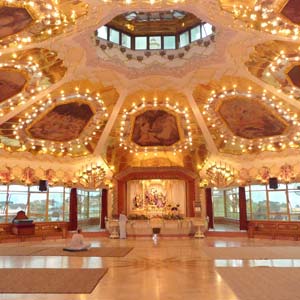 The Hare Krishna Temple, known as the Sri Sri Radhanath Temple of Understanding, in Chatsworth.
The Hare Krishna Temple, known as the Sri Sri Radhanath Temple of Understanding, in Chatsworth.
While most Indians consider themselves ‘South African’ before ‘Indian,’ they have retained a strong cultural heritage. There are temples and mosques wherever there is a sizeable Indian population. The Hare Krishna Temple, known as the Sri Sri Radhanath Temple of Understanding, with over two million visitors a year, is a major tourist attraction in the largely Indian area of Chatsworth. It is noted for its stunning architectural design and lavish marble tiles, gold-tinted windows, crystal chandeliers, and golden statuettes.
The majority of Indians practice a form of Hinduism that is not too concerned with caste, creed, and endogamy, but continues to observe traditional rituals. Diwali is a huge celebration, as are Holi, Navaratri, Eid, and Kavadi, which celebrates the god Murugan.
Bollywood enjoys a hold here, too, with Hindi movies subtitled in English broadcast on the South African TV channels a few hours every week, and satellite TV bringing Hindi and South Indian language shows into Indian homes. Indian radio stations like Lotus FM and Hindvani provide coverage of Indian music, news, and entertainment. Ethnic newspapers like the Post, Herald and Sunday Times Extra cater to Indian readers.
The Miss India South Africa Pageant attracts young hopefuls every year who display their cultural heritage, and many in the South African Indian community proudly recall that it was in South Africa that Aishwarya Rai won the Miss World crown in 1994. Indian dance forms like Kathak and Bharatanatyam are alive and well, too, along with fusions of Indian and African dance styles.
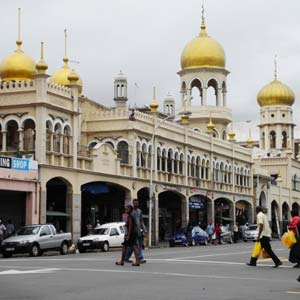 Durban’s Jummah Masjid is known to be one of the southern hemisphere’s largest mosques.
Durban’s Jummah Masjid is known to be one of the southern hemisphere’s largest mosques.
About 80 percent of Indians in South Africa live in KwaZulu Natal and its city of Durban. It has the largest concentration of Indians in any city outside of India. Indians form one of the majorities that own businesses. Durban reflects Indian cultural influences everywhere—its Victoria Street Market is redolent of the aroma of spices and incense.
The “bunny chow,” which is a dish unique to South African Indians, originated in Durban. This is a hollowed-out loaf of bread filled with an Indian curry of your choice. The term derived from the words “bunny” (referring to Bania or Gujarati-speaking people) and “chow” (slang for food). Every year the Bunny Chow Barometer competition attracts hundreds of entrants.
Interestingly, despite problems such as rampant crime, rising unemployment, and continued racial tension, for many like consultant nephrologist Vironica Chathury, South Africa will always be home. After returning from a recent vacation in Goa, Chathury commented, “Just returned yesterday and the first things that stood out were our fresh air, clean roads, courteous South Africans and gorgeous homes that I was so happy to return to!” She had considered emigrating a few years ago but decided against it, saying, “We have been part of our changing South Africa. Its rich culture, deep history, beautiful land, good people, and fast growing economy are a few great reasons to why no other country may compare! There is a huge sense of homeward-bound that will keep us rooted. The only other country I feel [the same way about] is New Zealand. But the natural disasters there versus the crime in SA reminds me that life balances itself out. You have to continue to strive to perfection, and crime is a controllable entity.”
Indeed, the government has made crime reduction one of its top priorities. Finance Minister Pravin Gordhan announced in 2011 that South Africa will inject billions of dollars into fighting crime this year, with funds being used to recruit more police officers, magistrates, and judges, increase the number of courts, and upgrade correctional services and facilities.
Despite the new set of difficult challenges Indians face, some of them have also reaped the benefits of post-apartheid South Africa, with their advantages of superior education and greater wealth. They were able to enter many sectors of trade and business that were denied to them in the past. Wealthy Indians can now move into more affluent residential areas that had been previously reserved for whites. Although affirmative action is seen as discriminating against Indians, opportunities opened up for them as white South Africans emigrated in hordes, leaving behind thousands of skilled job openings.
A transition that held much promise
The year 1994 marked a new chapter for South Africa when it transitioned from over 300 years of white rule to a black government. Apartheid was abolished and there was a radical shift of power. Thousands of South Africans took to the streets and danced and sang when Nelson Mandela became president of South Africa. There was a widespread feeling of euphoria as the new rule marked the end of the white domination over blacks, Indians, and “coloreds” in South Africa. The historic election also granted Indians the right to vote for the first time since their arrival in the country.
Indian faces could now be seen in the Cabinet, enjoying top posts like those of Finance Minister and Minister for Economic Development. Mac Maharaj, who had played a pivotal role in South Africa’s liberation movement, suffering brutal torture and 12 years in jail together with Nelson Mandela, is today spokesperson to President Zuma.
Not black enough
At his presidential inauguration, Nelson Mandela announced, “Never, never again will this beautiful land experience the oppression of one by another.” But the end of apartheid didn’t mean a happy ending—democracy in South Africa brought a new set of challenges for Indians.
Take the case of attorney Arshana Shyam Nirhoo, whose decision to leave the country reflects a growing concern among the Indian community that the government’s affirmative action policy favors the black population to the detriment of deserving Indians. She is concerned about the future of her four children and their professional growth in South Africa. “The minority groups in South Africa have become too complacent. Perhaps it’s fear of reprisals against them, or they lack the courage and confidence to stand up against injustice. Whatever it is, it does not bode well for the future of Indians in this country. It is disappointing that they have forgotten that their forefathers were also part of the struggle against apartheid, and therefore their children should not be subjected to additional discrimination by being rejected at tertiary institutions as a result of their skin color,” says Nirhoo.
Indians who were citizens before 1994 and were discriminated against by apartheid are considered black for the purposes of Employment Equity and are eligible for affirmative action, but some of them feel they suffer because they are viewed as being “not black enough.”
Nirode Bramdaw, who owned an Indian newspaper in South Africa, describes the hierarchy of preference for job-seekers: “If you’re a black woman, you can walk into any door right now. If you’re a black man, you’re second. Then come colored and Indian women, Indian and colored men, and then whites.”
While affirmative action was intended to redress past imbalances where blacks and Indians were denied the educational opportunities afforded to whites, many Indians feel that the policy is a means to marginalize them by reversing the discrimination in favor of blacks. “In the past we were not white enough, now we are not black enough” is a thought echoed by many Indians in everyday conversations and the media.
The late politician Amichand Rajbansi condemned affirmative action for “having a negative impact on the country.” He also felt the people who were in charge of the policy were applying it “unfairly.”
A growing sense of disenchantment
After apartheid, a fundamental question on the minds of South African minority groups (mostly Indian and white) has been whether to stay or to leave.
Research reveals that the majority of South Africa’s skilled population has considered emigrating since 1994, and that amongst Indians, the widespread urge to emigrate is a result of a growing sense of disillusionment, fear, and lack of faith in the country.
While material lifestyle is certainly a motivating factor in the brain-drain phenomenon luring South African Indians to more lucrative pastures abroad, it accounts for only a small reason why they leave, with social factors being the primary driver of emigration. The two most often cited reasons are crime and affirmative action.
Apartheid’s segregation of the races had insulated Indians to their own so-called ‘Indian areas.’ However, with the dismantling of segregation, people were free to live where they chose which resulted in an influx of other race groups that drove up crime in these areas.
While apartheid was an unjustifiable evil and had to go, many Indians felt that they had a better quality of life under apartheid. In 2002, the Chicago Tribune cited a survey conducted by the Institute of Democracy, in which the majority of South Africans looked back on the apartheid era with nostalgia and said they believed the country was run better then.
In an article on the experiences of Indian South Africans, Praveena Singh-Kaw wrote, “When the call for freedom came, Indians whole-heartedly joined in the fight. The cause was just and the time was right. Many Indians lost their lives in the apartheid struggle, many more were tortured and imprisoned. Yet today under the rule Indians fought so hard to achieve, they are being massacred on a weekly basis. Action needs to be taken or the entire Indian population faces extinction. As an Indian South African, and one who has participated in the Struggle for Freedom, I am appalled that I have to consider that life under the apartheid regime, while not optimal, was preferable to life in the new South Africa. I wonder what has become of the Indian politicians and the African National Congress activists who championed the fight for a free South Africa. Are they indifferent to the cries of Indian South Africans or have the Indians in South Africa fulfilled their role and are now dispensable?”
While the dismantling of apartheid liberated the Indians of South Africa, giving them more choices in life than their forefathers had dreamt of, conditions under the new rule have also made them prisoners in their own homes, cowering for fear that they may be robbed, assaulted, or even murdered at any time. Indian homes barricaded behind increasing layers of security, with panic alarms, guard dogs, and patrol groups are a common sight.
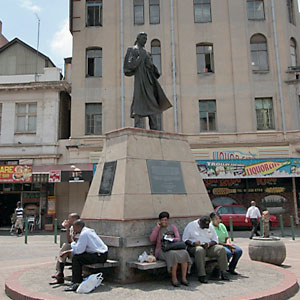 Gandhi Square in Johannesburg.
Gandhi Square in Johannesburg.
Eighteen years after apartheid was abolished, Indians are disappointed that South Africa has not lived up to its promise of racial equality and harmony. Who knows what the future holds for Indians in South Africa? Mahatma Gandhi had said: “The spirit of democracy is not a mechanical thing to be adjusted by the abolition of forms. It requires change of heart.” By that token, the dismantling of the apartheid laws in itself cannot eliminate racial tensions and inequalities, and unite the different race groups under a truly democratic South Africa, until the people themselves support that change.
Although Indians in South Africa have made significant progress since their forefathers arrived in the country as indentured laborers, their struggle for equality is far from over. According to T.G. Ramamurthi, author of the book Apartheid and Indian South Africans, “Ethnic Indians in South Africa were never a people, but have always been a ‘problem’, a ‘question,’ or an ‘issue.’”
Indians in South Africa seem to acknowledge that analysis with sadness as they contemplate the question that looms before them—can they not call this land home anymore?
Archana Shah is a South African Indian who is now settled in the United States.
Enjoyed reading Khabar magazine? Subscribe to Khabar and get a full digital copy of this Indian-American community magazine.
blog comments powered by Disqus










